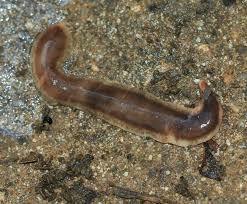Platyhelminthes


What are Platyhelminthes and how does their locomotion and defense work?
- Platyhelminthes are animals that lack respiratory, circulatory, and skeletal systems. Compared to other phylums, platyhelminthes are extremely primitive. Generalized as flatworms, platyhelminthes are aptly named for their flat bodies. Nearly 80% of all flatworms are parasites, a lifestyle that provides the animals with the necessary nutrients for survival. 25,000 species are extant with organisms falling into one of four classes: turbellaria (planarians), monogenea (parasites), trematoda (flukes), and cestoda (tapeworms).
- Of the four classes of flatworm, turbellaria contains the largest amount of independent species. Turbellarians move via perpetually-vibrating cilia surrounding their body gripping to secreted mucus. Turbellarians have no physical defenses but have camouflage and rapid regeneration, allowing their survival as long as they aren’t swallowed whole.
- Organisms in the class monogenea are exclusively parasites, often living their entire lives in or on a host. The prime method of transportation for monogeneans is on the host (should they need to move around), which is ensured for ectoparasites by adhesive suckers. A cuticle shields them from some damage by predators. However, it is unlikely that monogeneans are killed separately from their host due to their lack of independent movement.
- Trematodes, another type of parasite, also spend their existence with one or two hosts. As it matures, a trematode will kill its primary host (usually a mollusk) and will float in water for several days. When another animal absorbs the parasite through its skin, the worm stops needing to move. Not many defenses are possessed by trematodes, but they are the second most deadly parasite to humans behind malaria.
- The fourth class of trematoda is the cestoda, or tapeworms. Like the other parasitic platyhelminthes, cestodes seldom move on their own; the only time movement is necessary is when a host dies or becomes unusable. As larvae, however, cestodes swim through water in an attempt to be eaten by small crustaceans. Tapeworms live in their host’s intestines, absorbing nutrients through their skin. Cestodes don’t have any notable natural defenses, but due to their reliance on a host, they are protected by whatever defenses the host has.



